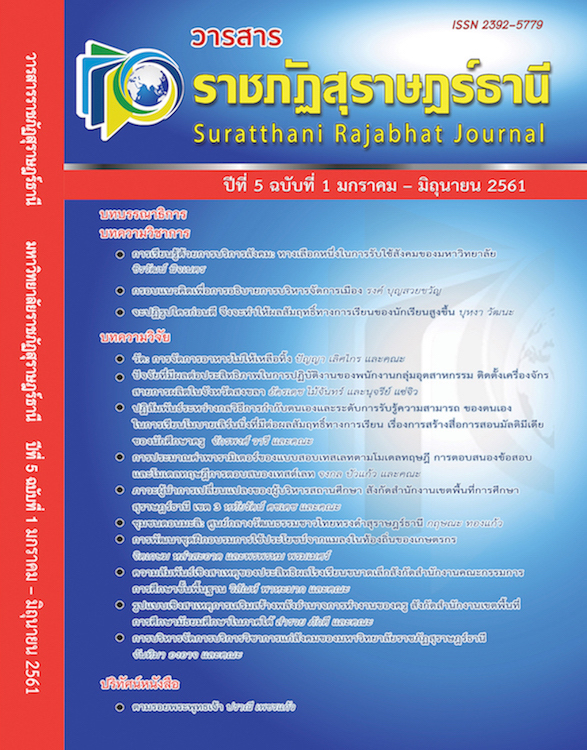The Administration of Academic Services for Society of Suratthani Rajabhat University
Main Article Content
Abstract
This research article aimed to study the administration of academic services for society and to create the operational guidelines for the administration of academic services of Suratthani Rajabhat University. Data were collected from 257 staff, who were in charge of Suratthani Rajabhat University in 2016, by using a questionnaire yielded a reliability coefficient of 0.98. The qualitative data were collected from 24 committee members of the academic services office by using focus group discussion method. The data obtained from the questionnaire were analyzed by using mean and standard deviation; whereas, the focus group discussion was analyzed by using content analysis.
The research findings showed that the administration of academic services for society of Suratthani Rajabhat University was implemented at a high level in every aspect in descending order: collaborative network creation with external organizations, determination of targets of academic services, participation of faculty members in implementation, preparation of academic services plans requiring participation of target groups, setting a goal for communities and agencies to be developed and strengthened tangibly, and implementation of continuous self-development of target communities or organizations. The analysis of problems showed that the problems were related to management structures and operation of central authorities; a lack of understanding about rules and guidelines for disbursement of the committee; a priority of academic services missions and calculated workload hours for the lecturers responsible for projects; project management and coordination with target areas; and lack of public relations.
The operational guidelines for the administration of academic services included the followings: have the central agencies established to clearly indicate the academic services structures and duties as well as to indicate the target area in order to study problems and needs; appoint the committee based on expertise; prepare academic service plans according to the principles of the university focusing on the participation of people in communities; have the operation of the projects integrated with teaching and research; build up the collaborative network for the operation with both internal and external agencies from public and private sectors; specify the operational boundary toward academic services for society from the strategy and every assessment criteria in order to achieve the goals for all sectors; and summarize the operation performance when projects were completely carried out for improvement.
Article Details
References
______. (2554). กรอบแผนระยะยาว 15 ปี มหาวิทยาลัยราชภัฏสุราษฎร์ธานี (พ.ศ. 2555 - 2569). สุราษฎร์ธานี : กองนโยบายและแผน มหาวิทยาลัยราชภัฏ สุราษฎร์ธานี.
ลักษมี สารบรรณ. (2557). คุณภาพ (Quality) คืออะไร. สงขลา : มหาวิทยาลัย สงขลานครินทร์.
สุรัสวดี อินทร์ชัย. (2551). การศึกษารูปแบบและวิธีการที่เหมาะสมในการให้บริการวิชาการแก่ชุมชนสำหรับมหาวิทยาลัยเอกชน กรณีศึกษา มหาวิทยาลัยพายัพกับมหาวิทยาลัยนอร์ท-เชียงใหม่. ปริญญานิพนธ์รัฐประศาสนศาสตรมหาบัณฑิต สาขารัฐประศาสนศาสตร์ บัณฑิตวิทยาลัย มหาวิทยาลัยเชียงใหม่.
อนันต์ เจ๊ะมามุ. (2556). แนวโน้มการบริการวิชาการแก่ชุมชนของวิทยาลัยอิสลามศึกษามหาวิทยาลัยสงขลานครินทร์ ในทศวรรษหน้า (พ.ศ. 2555 - 2564). วิทยานิพนธ์ศึกษาศาสตรมหาบัณฑิต สาขาการบริหารและการจัดการศึกษาอิสลาม บัณฑิตวิทยาลัย มหาวิทยาลัยสงขลานครินทร์.
สำนักงานคณะกรรมการการอุดมศึกษา. (2557). คู่มือการประกันคุณภาพการศึกษาภายในระดับอุดมศึกษาฉบับปีการศึกษา 2557. กรุงเทพฯ : สำนักมาตรฐาน และคุณภาพอุดมศึกษา สำนักงานคณะกรรมการการอุดมศึกษา.
สนทนากลุ่มตัวแทนคณะกรรมการบริการวิชาการ. โดยผู้วิจัย. วันที่ 5 กันยายน 2559. ประสานสุขรีสอร์ท อำเภอสิชล จังหวัดนครศรีธรรมราช.
Yamane, Taro. (1973). Statistics: An Introductory Analysis (3rd ed.). New york : Harper and Row Publication.

